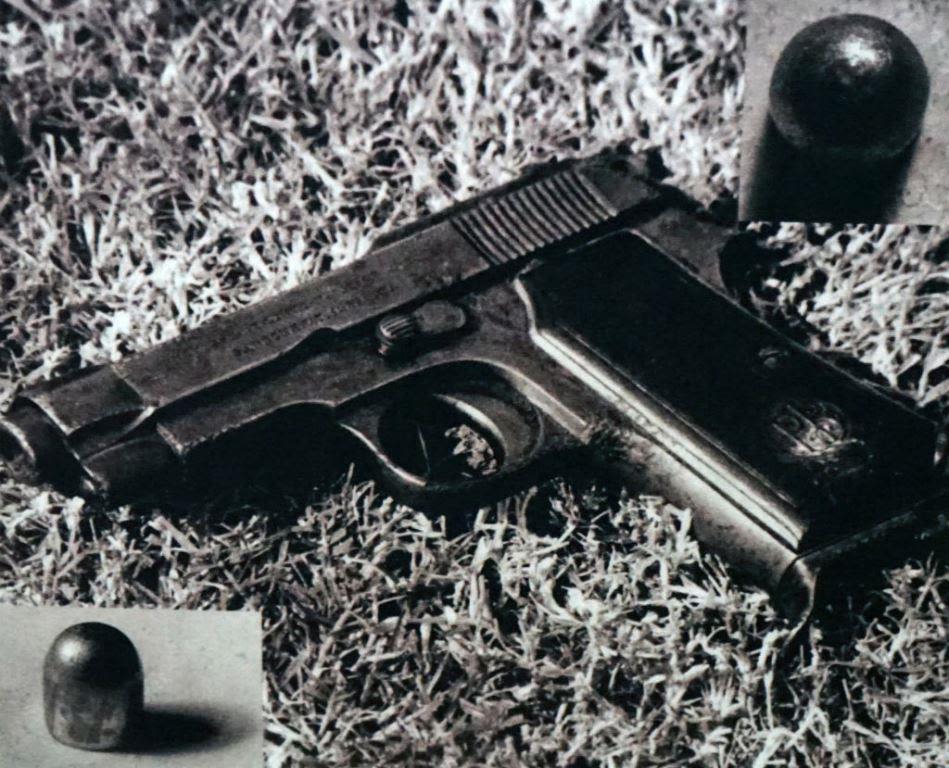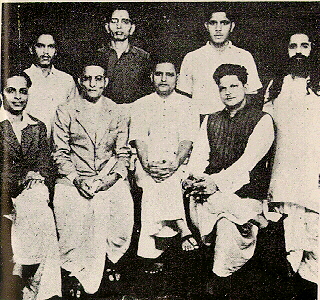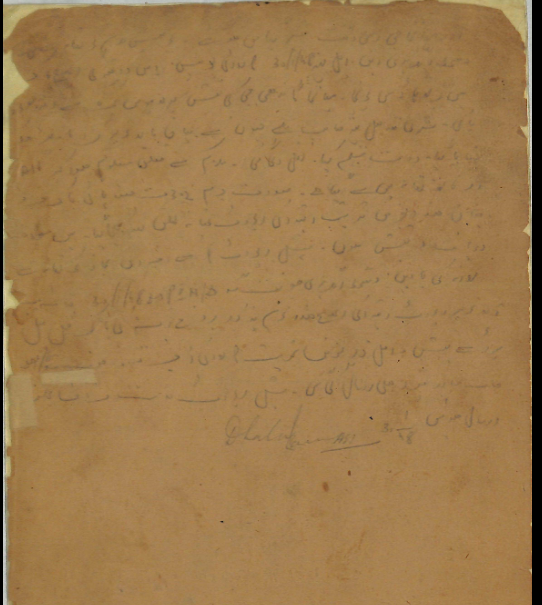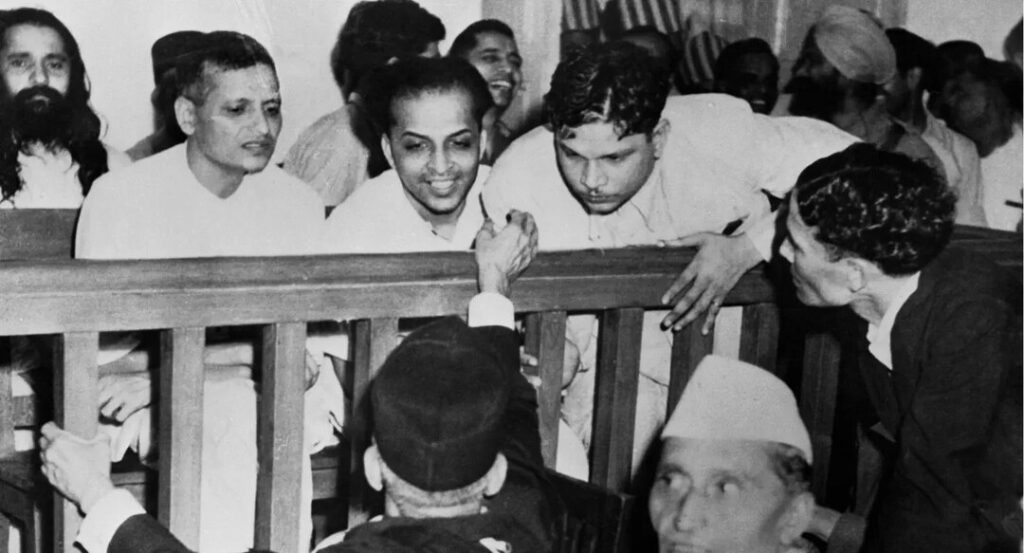On January 30, 1948, Nathuram Godse shot and killed Mahatma Gandhi at Birla House. At the moment of his assassination, Gandhi’s Ingersoll watch showed 5:17 PM. However, when this tragic news was announced on the radio at 6:00 PM, it was stated: “Today at 5:20 PM in New Delhi, Mahatma Gandhi was assassinated. His assassin was a Hindu.” The mention of the assassin’s religious identity was deliberately included to prevent communal violence from breaking out across India.
After assassinating Mahatma Gandhi, the murderer Nathuram Godse was arrested with a pistol in his hand. He made no attempt to escape, nor did he resist his arrest.

Other conspirators in Gandhi’s Assassination
When Nathuram Godse assassinated Mahatma Gandhi, two other conspirators, Narayan Apte and Vishnu Karkare, were present in the Birla House premises. After the assassination, they fled the scene. However, they were later arrested on February 14, 1948, from a hotel in Mumbai. Their arrest became possible when Narayan Apte called his lover to the hotel, unaware that the police had been monitoring her telephone. The authorities had already discovered that Apte was romantically involved with the daughter of his chief surgeon, which ultimately led to his capture.
On May 27, 1948, a case was officially registered for the conspiracy to assassinate Mahatma Gandhi, and eight individuals were charged. These included Nathuram Godse, his brother Gopal Godse, Narayan Apte, Madanlal Pahwa, Vishnu Karkare, Vinayak Damodar Savarkar, Dattatreya Parchure, and Digambar Badge’s servant, Shankar Kistaiya.
Digambar Badge was also involved in the conspiracy, but since he agreed to become a government witness, he was not prosecuted. His testimony played a crucial role in securing convictions for the other accused individuals.

The FIR of Mahatma Gandhi’s Assassination
The FIR of Mahatma Gandhi’s assassination, numbered 68, was recorded in Urdu under the light of a lantern on the night of January 30, 1948, at 9:45 PM. This historic document is still preserved at the Tughlak Road police station.
At the time of the assassination, Inspector Dasondha Singh was the Station House Officer (SHO) of Tughlak Road police station. He rushed to Birla House immediately after the incident. Deputy Superintendent of Police (DSP) Jaswant Singh also arrived at the scene. Both officers arrested Nathuram Godse and took him to the police station, where an FIR was registered based on the statement of eyewitness Nandlal Mehta. Some additional details were also included by SHO Dasondha Singh. A photocopy of this FIR is preserved at the National Gandhi Museum.

Special Court Formation
A special court was established for the trial of Mahatma Gandhi’s assassination case. The Government of India’s Ministry of Home Affairs constituted this court through an ordinance issued on May 4, 1948. On May 13, 1948, the case was officially assigned to this special court. The trial took place within the premises of the Red Fort, where the accused were also held. Under a special notification, the Red Fort was designated as a jail for the duration of the proceedings.
Beginning of the Trial
On May 27, 1948, the trial of Mahatma Gandhi’s assassination began in the special court of Judge Atma Charan. The prosecution was led by C. K. Daphtary, the then Advocate General of Mumbai, assisted by a legal team that included J. C. Shah. The main accused, Nathuram Godse, was represented by V. V. Oak, while the co-conspirators had their own defense lawyers, with prominent names including K. H. Mangal, G. K. Dua, and P. L. Inamdar.
Between June and November 1948, the court heard testimonies from 149 witnesses, and the prosecution presented 404 documents as evidence.
A major challenge in the trial was the language barrier. Vishnu Karkare spoke Marathi, Shankar Kistaiya understood Telugu, and Madanlal Pahwa was comfortable in Hindustani and Punjabi. With witnesses from diverse linguistic backgrounds, proceedings became even more complex.
To resolve this, the court appointed three interpreters to facilitate communication. While this ensured clarity, it also prolonged the trial, as every question and response had to be translated into multiple languages, including English, Gujarati, Marathi, Telugu, Hindustani, and Punjabi.
Judgment of the Trial
February 10, 1949, marked the day of the verdict in the Mahatma Gandhi assassination case. On this day, tight security measures were put in place around the Red Fort to prevent any potential disturbances or unrest.
At precisely 11:20 AM, all eight accused, including Nathuram Godse, were brought into the courtroom. During this moment, Nathuram Godse, Narayan Apte, and Vishnu Karkare were seen smiling, while Vinayak Damodar Savarkar remained calm and serious.
At 11:30 AM, Judge Atma Charan entered the courtroom and began delivering the judgment. Nathuram Godse, the main perpetrator of the assassination, was sentenced to death, along with co-accused Narayan Apte, who was sentenced to death for purchasing the weapon used in Gandhi’s assassination.
Vinayak Damodar Savarkar was acquitted due to lack of evidence and ordered to be immediately released. However, after his retirement, Jamshed Dorab Nagarwala, the Chief Investigating Officer in the case, stated, “I completely agree that the assassination of Mahatma Gandhi could not have been carried out without Savarkar’s involvement and assistance.” This was referenced by Tushar Gandhi in his book “Let’s Kill Gandhi.”
The remaining five accused—Gopal Godse, Vishnu Karkare, Madanlal Pahwa, Dattatray Parchure, and Shankar Kistaiya—were sentenced to life imprisonment. All the accused were given the right to appeal the verdict in a higher court.

Appeal of the Accused in the High Court
Nathuram Godse and the other accused appealed against the trial court’s verdict in the Punjab High Court, which was then located in Shimla.
What made this appeal particularly interesting was that, instead of challenging his conviction, Godse objected to the court’s conclusion that he was not the sole conspirator in Gandhi’s assassination. He firmly maintained that he alone had killed Mahatma Gandhi for political reasons and that no one else was involved in the conspiracy.
The case was heard by a bench of the Punjab High Court comprising Justice Khosla, Justice Bhandari, and Justice Achhru Ram. During the proceedings, Godse refused legal representation and chose to argue his case himself.
Justice G.D. Khosla later authored a book in 1965 titled The Murder of the Mahatma, in which he noted that Godse showed no remorse for his actions. During the trial, Godse read out a 150-paragraph statement in court, which took him over five hours to complete.
On June 21, 1949, the Punjab High Court delivered its judgment, acquitting Shankar Kistaiya and Dattatreya Parchure while upholding the sentences of the remaining accused.
The five convicts in Mahatma Gandhi’s assassination—Nathuram Godse, Narayan Apte, Gopal Godse, Madanlal Pahwa, and Vishnu Karkare—filed a special leave petition to appeal before the Privy Council. However, their request was rejected.
Subsequently, a mercy petition was submitted to the Governor-General on behalf of Nathuram Godse’s parents. This petition bore the signatures of several of Mahatma Gandhi’s close associates, including his two sons, Manilal Gandhi and Ramdas Gandhi. Despite this, the plea was denied.
Finally, on November 15, 1949, Nathuram Godse and Narayan Apte were executed in Ambala Jail. The remaining three accused—Gopal Godse, Madanlal Pahwa, and Vishnu Karkare—were sentenced to life imprisonment.
After the Trial
After being acquitted on appeal, Dattatreya Parchure began running his own clinic in Gwalior. Digambar Badge, who faced a threat to his life in Pune, relocated to Mumbai and stayed in a house provided by the police. There, he resumed his previous work of crafting iron armor.
Vishnu Karkare, Madanlal Pahwa, and Gopal Godse were released from prison on October 13, 1964, after serving their sentences. Vishnu Karkare moved to Ahmednagar, where he operated the Deccan Guest House until his death from a heart attack in 1974. Madanlal Pahwa settled in Mumbai, where he began working in the toy industry. In 1966, he married a woman named Manjari, and he passed away in Dadar in 2000. Gopal Godse moved to the third floor of a modest house in Pune, where he lived until his death on November 26, 2005, as the last surviving conspirator in the assassination of Mahatma Gandhi.

Why I Assassinated Mahatma Gandhi (Nathuram Godse) – https://amzn.in/d/8OgHnFQ
Mahad Satyagraha – https://infowebindia.com/history/mahad-satyagraha-1927/